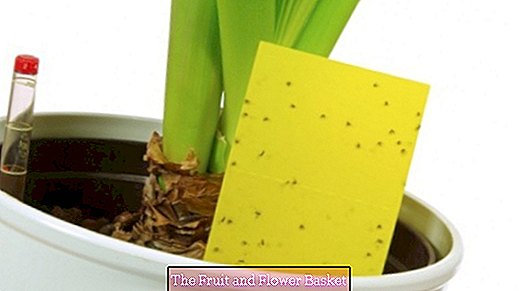Fight thrips (thunderstorms)
thrips, also thrips or thrips called, represent a classification class of insects. Their scientific name is Thysanoptera. In the vernacular, they are, depending on the regional dialect, called thunderstorms, Hommelmösche, Flimmerchen, Putsigel, Knaupanne or Wettergeistlein.Weltweit exist about 5,500 species of which currently 214 in Germany. The terms "fringed wing" and "bladder feet" indicate two anatomical features of the one to three millimeters small insect: First, their wings have long fringes on the edges. On the other hand, balloon-like protuberances on the leg ends serve to move on smooth surfaces.
Not all types of fringed winglets actually have wings; here ranges from fully trained to nonexistent. Due to the usually poor flying ability, thrips rely on the wind as a means of transportation.
Thrips as molesters
Especially in hot and humid weather, thrips often occur in large numbers (thunderstorms) and especially like to gather on objects or items of clothing in their "favorite colors" yellow and light blue. They pose no health hazard to humans, but can sting in the attempt to absorb sweat and cause slight Hauirritationen. Due to their small size, thrips can easily be put into houses and display a particularly annoying behavior here: they penetrate through the ventilation slots of TFT flat screens into the narrow space between the panel glass and the diffuser film. There they visibly move in front of the background image until they die and remain in the image of the monitor. With guarantee claims one depends on an accommodation on the part of the screen manufacturer? a uniform handling does not exist so far.
Thrips as pests
While thrips are annoying to humans, they can cause serious damage to plants. Both in agriculture and in the private sector, the plant infection by thrips has increased significantly in recent years. Especially in the warm climate of greenhouses or indoor plants they find ideal living conditions and can become a real plague.
With their asymmetrical mouthparts, they sting individual cells of the infested plant and suck out the sap. Due to the subsequent penetration of air into the cells, they first shimmer silvery and gradually become yellowish spots. With the air, fungal spores invade the damaged cells and further damage the plant. The effects are similar to those of an attack by spider mites, but in contrast to these thrips are visible to the naked eye. In case of strong attack by thrips, the leaves of the plant dry up and are discarded prematurely. In addition, thrips may be responsible for the spread of various plant viruses.
The recognition of thrips
If there is uncertainty about the type of pest infestation, so-called glue or color charts from specialist retailers can help. These are cardboard boards, mainly in the colors yellow and blue, which are coated with a special glue. They are placed between the possibly infected plants and attract the pests. These stick (as with a flypaper) on the glue layer and can be specified.
The effective fight against thrips
Thrips have a number of natural enemies that can be used to target the pests. These predators, called beneficial insects of the thrips, are targeted to the affected plants and release them from the pests, without in turn damaging the plant. Benefits against thrips, especially various types of predatory mites, are available from specialist retailers.
As an effective home remedy for thrips on indoor plants, spraying with a soap suds has proven itself. This is very easy to prepare: one liter of water is mixed with two tablespoons of olive oil and a good dash of detergent. Alternatively, 15 grams of pure soft soap can be dissolved in one liter of warm water. With a nebulizer, the soap solution is then sprayed on the affected plants. Here, especially the thrips preferred leaf undersides should be treated.
As a rule, a chemical fight against thrips in the private sector should be avoided. Even without this "Cannon sparrow" variant, it will be possible to successfully combat the thrips with the above-mentioned "gentle" methods.
Have you already had experiences with thrips? Any addition to the tips presented here is welcome!





